|






| |
Joe observes using the Victoria
Centre Observatory's Meade LX200 14" SCT and Tele Vue NP 127 apochromatic refractor,
both mounted on a Paramount ME. The
VCO's LX200 is used mainly for visual observing and astrophotography of deep space objects and other objects
which require tracking, guiding, and/or high magnification (lunar eclipses, comets, planets,
small deep space objects, etc.).
Joe uses a Skywatcher 6" Dobsonian as a grab-and-go visual scope, and a Borg 101
ED mounted on a HEQ5 Pro mount for wide field astrophotography as well as visual
observing which requires a tracking and/or goto mount. A Lunt LS60THa + LS50FHa
solar telescope mounted on an HEQ5 is used exclusively for solar viewing and photography. Imaging
equipment includes a Canon 7D dSLR, some Canon L-series telephoto lenses, as well as the VCO's QSI 583c CCD
camera. Joe has made use of a wide variety of imaging equipment and observing
hardware in the past - please see below for particulars.
Joe's personal astronomy website
Please note: the page below contains an archive of
Joe's images dated
from 2005 through mid-2007.
Photos from mid-2007 onward can be found on
Joe's Zenfolio Online Gallery
(see above slideshow).
| Costa Rica Southern Sky Fiesta - February 2008
The Southern Sky Fiesta tour is sponsored by Sky and Telescope magazine,
and is
hosted by one of their Contributing Editors, Gary Seronick. The tour is
arranged by Travelquest, who specialize in astronomy tours (especially
solar eclipses). After hearing Gary's presentation at our
2006 AGM, I promised myself that
some day I would take the tour he has hosted for the last five years. Since I am recently retired,
2008 was that "some day", so I signed up for the tour (as did
John McDonald
and his wife Wendy).
The site in Costa Rica which Gary and S&T chose for this tour is very conducive to
astronomical observing and astrophotography. La Ensenada "Star" Lodge is
located well away from the Capital of San Jose, and is on the dry Pacific coast
of Costa Rica, however it does see some light
pollution from the nearby town of Puntarenes in the SE sky. Nonetheless,
magnitude
6 skies that are extremely stable are a fact at this site. The Lodge staff work very hard to
ensure night vision is preserved - there are no white lights to be found
anywhere where the guests are likely to be observing from. Over the
last five years, this tour has been refined to well serve amateur
astronomers keen to catch a glimpse of the southern sky. La Ensenada
is located at 10� north latitude, so many of the jewels in the southern sky are visible
from here. Both John and I captured some nice
images of the southern sky, and unlike our observing in Canada, it was all
done without having to get bundled up against the cold! Average night time temperature was about 30�C. I had to take new dark frames to
compensate for the high temperatures! |
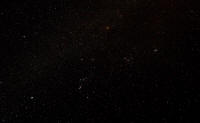
The Milky Way centred on Orion
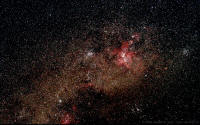
Eta Carina |
| M82 Cigar Galaxy - July 5, 2007 Last evening my
main target was M82, the Cigar Galaxy. The attached image is my best effort
to date, and shows quite a bit of detail and colour for this irregular
galaxy.
This is a stack of 34 images (ISO 3200, 60 secs each) taken with a Canon 30D
at prime focus on my LX200R 8". Caibration using dark/flat/bias frames was
applied using ImagesPlus. Noise reduction was applied using Neat Image
defaults, and then digital development was applied using ImagesPlus.
Additional modest image enhancement, cropping, and image size and colour
depth reduction was done using Corel PhotoPaint. |
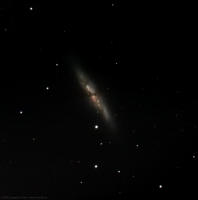 |
Jupiter - July 4, 2007 at 11:18pm PDT
Jupiter - July 3, 2007 at 11:34pm PDTThese photos
of Jupiter were taken from Observatory Hill. The seeing was superb for the
first few hours after twilight, yielding quite a bit of detail and some
wonderful colour. Two of the closest moons are also just visible near the
left and right edges of the top-most frame, and the bottom frame shows two
moons as well.
Details for both images:
Meade LX200R 8", operating at f/25 (2.5x Powermate), Meade LPI a-focal,
Envisage software (stack of 200 images). Some modest image enhancement was
performed using ACDSee 8 Photo Manager. |
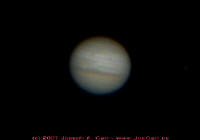
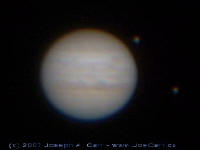 |
| Lunar "X" Feature - May 23, 2007 11:44pm I have
observed the Lunar "X" feature several times now, however this event
produced the brightest "X" by far. Here is an image I took of this
feature through my TV-76 a-focally using a 2.5x Powermate and my Canon 30D.
Details: ISO 800, 1/125 sec. jpg image processed in ACDSee 8 Photo
Manager - increased gamma and cropped. |
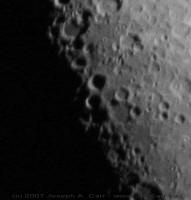 |
| M104, Sombrero Galaxy - May 4 & 17, 2007 This
image is a combination of 38 images (30 sec, ISO 3200) acquired over two
evenings from John McDonald's back yard
using my Meade LX200R 8" operating at f/10 with a non-modified Canon 30D at
prime focus. My image certainly isn't as deep as John's, so perhaps these
modified cameras just "see" better generally, despite the configuration
differences between our two setups. |
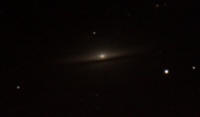 |
| Saturn - Feb 26, 2007 9:15pm PST
Astronomy Caf� has been
rained out or clouded out for so long, we can't remember the last time we
actually did some observing on Monday night. This evening presented us
with mostly clear skies - an opportunity we simply couldn't pass up. I
decided to concentrate on imaging Saturn, since this shallower ring
orientation is something new for me. Both the planetary shadow on the
rings and the rings' shadow on the planet are visible, as well as a
mid-latitude band and a polar region.
Details: Meade LPI mounted a-focal on Meade 8" LX200R operating at f/10,
Exposure: 0.35 sec
Processing: Meade Autostar Suite Envisage auto-stacking, Hard Contrast, 70%
quality setting. 200 original images stacked. |
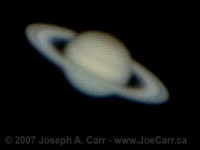 |
| Comet
McNaught C2006 P1 - Jan 11, 2007 5:42pm PST This image is taken from my back porch, which looks westward where the Sun had just set. I scanned the western horizon with my 9x63 binoculars, and there it was - Comet McNaught! When I looked again without the binoculars, it was an easy target. The comet has a very bright core, and a super long and broad tail.
I observed and photographed this comet just in the nick of time, since it is quickly approaching the Sun, after which our fellow observers in the southern hemisphere will be most favoured for views of this wonderful comet.
Exposure: 1/13,
ISO: 800
Camera/lens: Canon 30D dSLR, Canon EF 400mm L f/5.6 operating at f/6.3
Processing: Default noise reduction using NeatImage, cropped, saturation
increased using Corel PhotoPaint X3
|
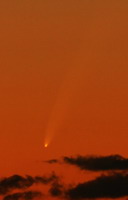 |
| Transit of Mercury - Nov 8, 2006 David
Lee, Guy Walton and myself observed the Transit of Mercury from Observatory
Hill this morning under cloudy skies. We were treated to enough
sucker holes in the clouds to allow us to both observe and photograph
the first part of this event.
Personally, this was thrilling - my first transit, and my first Transit
of Mercury! I also gave the Achannel
an interview (894k
wmv, used with permission), as President of our Victoria Centre.
As you will see, the photographs have poor resolution due to all the
cloud we were shooting through, but the progress of the Transit is clearly
visible (7 o'clock position), as is the quite large sunspot (8 o'clock
position).
Details:
Exposure: 1/125 to 1/640
ISO: 100
Camera/lens: Canon 30D dSLR, Canon EF 400mm L f/5.6 operating at f/6.3
Processing:
Single images, cropped, contrast stretched, noise reduction using ACDSee 8
and NeatImage.
|
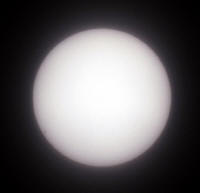
Mercury Transit through the clouds, taken 10 minutes after start |
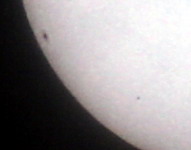
Mercury Transit through the clouds, taken 38 minutes after start |
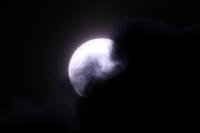
Mercury Transit - Mercury obscured by more clouds, taken 39 minutes after
the start |
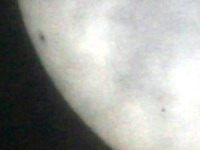
Mercury Transit through the clouds, taken 45 minutes after the start |
| Comet C/2006 M4 Swan - Oct 30, 2006 My latest
image of Comet Swan was taken Monday evening when David Lee and I travelled
to Sandy Barta's place to find some dark sky. The dust tail is super long
(over 3� in this image), and if you look closely you will see a short ion
tail just to the right of the big one. The head of this comet is so huge and
bright, I could easily spot it in my finder scope. The image shows the head
is not perfectly round, which indicates the comet is fragmenting. The bright
star below the comet is 58-Epsilon Herculis.
Details:
26 raw images (30 seconds, ISO3200) taken with my Canon 30D and Canon 400mm
L telephoto (operating at f/6.3) piggybacked on the Meade LX200R (tracking,
no guiding). Processed in ImagesPlus centroid/translate&rotate, aligned on
the comet head and a star in the comet's tail. Combined using Adaptive
Addition (3.0), aggressive Digital Development, then default noise reduction
in NeatImage, and finally cropped and colour depth reduced in Corel
Photopaint X3. |
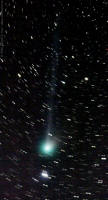 |
| Comet C/2006 M4 Swan - Oct 16, 2006 I managed to
use 9 images for this stacked image of Comet C/2006 M4 Swan. Canon 30D, 30
seconds, ISO 3200, Canon EF 400mm f/5.6L telephoto operating at f/6.3,
piggybacked on my LX-200R tracking on the comet. Processed using ImagesPlus,
sigma clipped average 1.4, and NeatImage.
There is a hint of twin tails at the 1 and 2 o'clock positions in the image.
Considering the brightness of this comet's core, it should yield spectacular
images if we can find darker skies and acquire more images. |
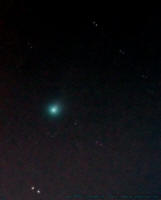 |
| NGC7789, an Open Cluster & NGC5907, Splinter Galaxy -
Sep 29, 2006 Several members had a good observing session atop
Observatory Hill on Friday night. We enjoyed wonderfully warm temperatures
as we were above the fog bank enveloping much of the city, and the air was
quite stable - a bonus for those of us who are astrophotographers.
I decided to image one of Malcolm Scrimger's favourite Open Clusters:
NGC7789 (20 sec, ISO 3200). This was a relatively easy target with my
Canon 30D at prime focus on my 8" Meade LX-200R. There are a remarkable
number of red stars in this cluster, but it still has a good number of blue
and white stars visible as well. A very interesting cluster.
I also had time to take images of the Splinter Galaxy (using the same
setup), one of many objects Blair was hunting down with his 12" Dob. This
faint object was more difficult to photograph, but I managed to obtain 14
images I could stack, and a reasonable image resulted (60 sec, ISO 3200).
More detail would be visible and less noise would be apparent if I had managed to acquire more usable images
for this edge-on galaxy. |
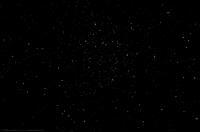
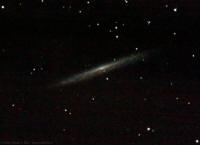 |
| Moon - SMART-1 Impact - Sep 2, 2006 10:42:15pm PDT
Several members observed the SMART-1 lunar satellite impact from Observatory
Hill. I used my Meade LX-200R 8" and the Meade LPI imager to take a
total of 1,584 jpg frames covering the event from 10:37:48pm to 10:49:28pm
PDT. The image to the right links to a 2 minute video extracted from the
middle of this sequence, covering the event 1 minute either side of the
impact in real time (i.e. video not slowed down or speeded up).
I don't see any impact or resulting plume in the terminator region in my
video, however the
CFHT successfully took an Image of SMART-1 Impact. Please view my video
and let me know if you spot anything.
Finder chart
(257k jpg). |
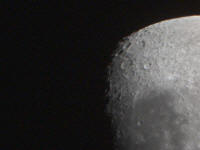
[4.7Mb AVI movie]
Please note: I used the Indeo 5.10 codec to compress this AVI.
If you have trouble playing the video on your computer, please follow the
codec installation instructions on
this page.
|
M101, Pinwheel Galaxy - Aug 27, 2006
I have acquired images of M101, Pinwheel Galaxy over three nights in the
last while. It is a very difficult object to image, mainly because its
surface brightness is so low. This is a composite image of a stack of 25 of
the best images. Taken with a Canon 30D at ISO 3200 for 1 minute each, prime
focus on LX-200R 8". Extensive processing in ImagesPlus, Neat Image and
Corel Photopaint X3.
Perhaps if I acquire another 25 images, I might be able to reduce the noise
somewhat. M51 and M102 are targets of mine that present similar imaging
difficulties. |
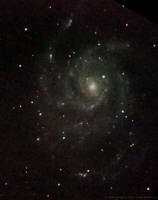 |
M45, Pleiades - Aug 24, 2006
This image of the Pleiades is taken from Cattle Point when they
were only 20� above the horizon in the NE sky after midnight. Despite the
heavy moisture content in the air, Guy, Charles and I continued to take
images, fighting off the dewing as best we could.
This is my first image of the Pleiades where I have captured some nebulosity
surrounding this well-known cluster.
Image taken with a Canon 30D & 400mm telephoto piggybacked on a Meade
LX-200R with autoguiding enabled using Meade LPI and Envisage. Processing:
- ImagesPlus: raw development, apply dark, bias and flat frames, align and
stack using Adaptive Addition 3.0, aggressive digital development
- Corel Photopaint: cropping, resizing, midtone increase, translate 48 bit
to 24 bit RGB |
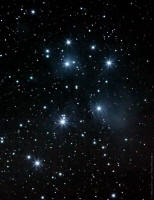 |
NGC6960, the Western Veil Nebula - Aug 24, 2006
This image of NGC6960, the Western Veil Nebula is also taken from Cattle
Point last night . This is my first image of the Veil Nebula, since previous
telescope platforms did not permit me to expose for long enough to see such
a faint image. Now with the combination of the Canon 30D operating at ISO
3200 and the LX-200R autoguiding, it is possible to gather significantly
more photons.
Platform:
- Canon 30D & 400mm telephoto piggybacked on a Meade LX-200R
- Autoguiding using the Meade LPI and Envisage software
Processing:
- ImagesPlus: raw development, apply dark, bias and flat frames, align and
stack using Adaptive Addition 3.0, aggressive digital development
- Corel Photopaint: cropping, resizing, midtone increase, translate 48 bit
to 24 bit RGB
As you will see, this image passes the limits of the Alt-Az mount, since
obvious field rotation is visible. Nonetheless, the image represents a good
start to photographing more faint objects. I could mount the LX-200R on my
wedge, and eliminate the field rotation problem...something to work on in
the future! |
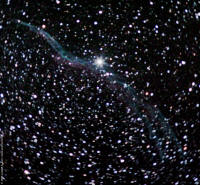 |
| Andromeda Galaxy - M31, M32, M110 - Aug 18, 2006
Last night several of us went to Cattle Point, and had a good
observing/photo session. The air was quite stable, although there was
considerable moisture in the air. I wanted to add to the 7 guided images of
Andromeda Galaxy taken a few nights before.
The attached image is a stack of 30 images exposed for 2 minutes at ISO
3200, which has produced my deepest image of Andromeda to date. Processing
in ImagesPlus, Neat Image, and Corel Photopaint: aggressive Digital
Development, and colour temp warmed to compensate for the IDAS LPS filter I
was using.
M31, Andromeda Galaxy dominates the image with lots of dark lanes and
mottling visible. M32 galaxy is visible in the lower part of M31's arms.
M110 galaxy sits high above M31 centre-top of the image, and finally NGC206
galaxy is discernable in the right side of M31's arms. Some colour is also
visible and more of the M31 galaxy is visible in this image, so the extra
depth contributed by the higher number of images used has visibly improved
my previous effort. |
 |
| Andromeda Galaxy - M31, M32, M110 - Aug 14, 2006
Malcolm Scrimger and myself observed from Cattle Point until the Moon rose,
giving us about 1.5 hours of dark skies. This is the deepest image of
Andromeda I've achieved to date, and is also my first guided astrophotograph.
Guiding done using my Meade LX-200R 8" Ritchy-Cretien and a Meade LPI and
Envisage software.
Photo taken with a Canon 30D and 400mm L series telephoto (efl=640mm)
piggybacked on the LX-200R. 2 minute exposures at ISO 3200, 7 frames
developed calibrated, aligned, stacked (average), and moderate digital
development using ImagesPlus. Noise reduction using Neat Image, and cropped
& finished using Corel Photo Paint X3. |
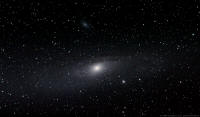 |
M27, Dumbell Nebula - July 26, 2006
Charles Banville, Malcolm Scrimger and myself went to Cattle Point last
night to observe. I was testing my new Meade LX-200R 8" Ritchy-Chr�tien
(third light), so I decided to image an object I've already imaged before so
I could compare.
This photo of Dumbell Nebula is a stack of only 6 images out of 30,
however increasing my exposure time from 45
seconds to 60 seconds and increasing ISO from 1600 to 3200 gave me a bit
more signal to work with than my previous photo despite only using 6 images. |
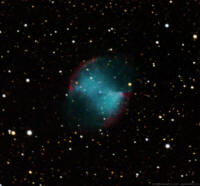 |
| Andromeda Galaxy - M31, M32 - July 21, 2006 Here
is an image of our old friend Andromeda Galaxy M31 & M32. The detail
in the dark lanes of M31 are the best I've achieved so far.
Taken with a Canon 30D prime focus on an LX-90 operating at f/6.3. I used
20 images out of a total of 30, ISO 3200 for 30 seconds each, taken from the
old 16" site on Observatory Hill on July 21st. Processed with ImagesPlus,
Neat Image, and Corel Photopaint. |
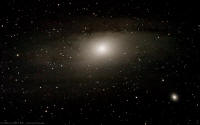 |
| Deer Lick Group, NGC7331 - July 20/21, 2006 A few
of us took advantage of the good weather the night before the Island Star
Party by observing from Observatory Hill on July 20/21. I decided to try
photographing a new and interesting object, the Deer Lick Group from the old
16" site as I fought off the mosquitos. In addition to the large galaxy
NGC7331 which dominates this image, several satellite galaxies are also
visible: NGC7335, NGC7336, NGC7337 and NGC7340. There was not much to see
visually, but this group photographs quite well.
Canon 30D prime focus on LX-90 f/10. This astrophoto is a stack of 29 images
out of a total of 50 originals, 30 seconds exposure time each, taken with my
Canon 30D prime focus on my Meade LX-90 at f/10. ImagesPlus, NeatImage and
Corel PhotoPaint were all used to process the image. |
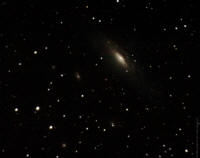 |
| M82, Cigar Galaxy - July 15, 2006 Last night on
Observatory Hill I decided to concentrate on imaging each of the two Messier
objects M81 and M82 individually using my Canon 30D dSLR mounted prime focus
on my LX-90 at f/10, shooting at ISO 3200 for 30 second exposure times. Here
is the M82 Cigar Nebula image after processing.
Using ImagesPlus I graded 37 raw images acceptable out of 45 original
images, then converted them to FITS. Calibrated using dark, bias and flat
frames, aligned, then combined using Adaptive Addition (3.5) and applied a
fairly aggressive Digital Development (DD). Default Neat Image processing
for noise reduction, although there wasn't much noise in the resultant
images. Cropped and further contrast stretched using DD in ImagesPlus.
Converted to 24 bit RGB using Corel PhotoPaint and output the resulting jpg
file. |
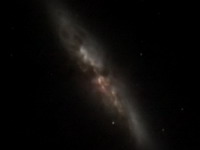 |
| M81, Bode's Galaxy - July 15, 2006 I'm not nearly
as pleased with this image as the M82 image (above). This object will
obviously require many more 30 second images, and/or a longer exposure than
30 seconds. The low surface brightness makes it a difficult object to
image using a dSLR at f/10.
See above M82 for processing steps. The only difference is that I
used an even more aggressive Digital Development in ImagesPlus to process
this image. |
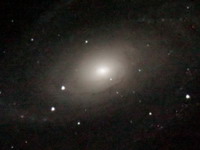 |
| M3, Globular Cluster - July 8, 2006 1:15am I have
found that the brighter Globular Clusters can be observed from my
light-polluted location at home, so given that we were at the Centre of the
Universe with an almost Full Moon staring at us, I decided to try imaging
M3. Again, I used ISO 3200 at 30 second exposures, however when I
graded the 30 original images, there were only 17 keepers. I have a feeling
the higher rejection rate was caused by poorer seeing and perhaps the CU
deck was vibrating a bit.
Canon 30D dSLR at prime focus on a Meade LX-90 operating at f/10. ImagesPlus:
digital development, calibration, alignment, combining using Adaptive
Addition 2.5, moderate Digital Development. Corel PhotoPaint: 42 bit image reduced to 24 bit, then resized for website
display. |
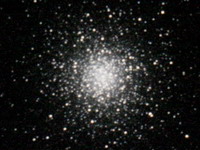 |
| M81 & M82 widefield - July 3, 2006 This wide field
image taken from Cattle Point shows the region covering both M81 and M82.
Taken with my Canon 400mm telephoto and 30D dSLR piggybacked on my Meade
LX-90.
ImagesPlus:
digital development, calibration, alignment, combining using Adaptive
Addition 2.7, moderate Digital Development, cropped. Filtered with NeatImage
defaults. Corel PhotoPaint: 42 bit image reduced to 24 bit, then resized for website
display. |
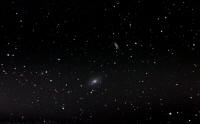 |
| NGC7000, North America Nebula - July 1, 2006 12:25am
This is how I finished off our observing session at Cattle Point - shooting
the N.A. Nebula using my Canon 400mm telephoto and 30D dSLR piggybacked on
my Meade LX-90.
Charles Banville and
John McDonald had both imaged this nebula
with good results, so I wanted to see what my gear would deliver.
Again, I used ISO 3200 at 30 second exposures, and again, when I processed
the 30 original images, there were 27 keepers. This allowed me to
enhance the overall signal-to-noise ratio, and supported my aggressive
digital development of the resultant image you see here.
Please refer to my
Deep Space personal
website for image processing details. |
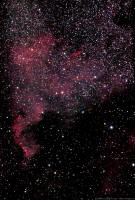 |
| M20, Trifid Nebula - June 30, 2006 11:20pm The conditions
at Cattle Point were very good, especially as I was shooting this image over
the water in a SE direction. I tried pushing my new Canon 30D dSLR to
ISO 3200 for this image, and it seems to have worked out quite well.
After subtracting dark frames and a flat field, I was left with an image
with lots of dynamic range to process. I also increased my yield of usable
images with the subsequent reduction in time needed to capture this object -
27 out of 30 images used.
Canon 30D at prime focus on my LX-90 operating at f/6.3. ImagesPlus:
digital development, calibration, alignment, combining using Adaptive
Addition 2.5, fairly aggressive Digital Development. Default noise reduction
using NeatImage. Saturation, mid-tones, contrast adjusted using Corel
PhotoPaint. 42 bit image reduced to 24 bit, then resized for website
display. |
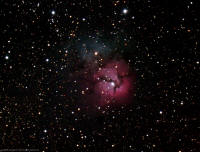 |
| M27 - Dumbell Nebula - June 29, 2006 12:15am Out
of 30 images taken at Cattle Point, only 8 were usable to create this image.
Despite this handicap, the resultant image turned out quite well. Canon 30D
at prime focus on the back of the LX/90 operating at f/10.
Please refer to my
Deep Space personal
website for image processing details. |
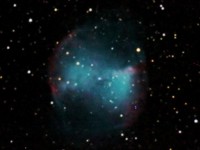 |
M51 - Whirlpool Galaxy - June 25, 2006 1:00am
I acquired 30 images of M51 on Observatory Hill Saturday night using my
Canon 30D at prime focus on my LX-90. 14 of the images were of suitable
quality to stack. This is my first image of M51 in which some detail is
visible - it is an exceedingly dim object!
The "b" version has the
supernova highlighted. |
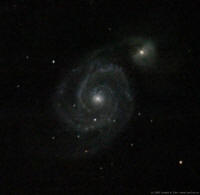 |
| M8 - Lagoon Nebula
- NGC6530 cluster - June 24, 2006 12:43am
Guy Walton, John McDonald and I setup at Cattle Point as
a last minute arrangement, however I think we are all glad we made the
effort. The sky was spongy in spots, but otherwise stable, yielding
some very good images. This is my second try at photographing the
Lagoon Nebula, and my first image of a deep space object using my new Canon
30D dSLR.
21 images used out of 30 taken, with Dark Frames
applied. Please refer to my
Deep Space personal
website for image processing details. |
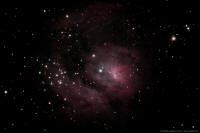 |
| Europa Shadow Transit of Jupiter - June 10, 2006
11:34pm-12:34am (11th) Guy and I stayed to enjoy the clear skies after the public left
Observatory Hill on Saturday night. I took a series
of 24 resultant images using the Meade LPI webcam and Envisage software on a Meade
LX-90 f/10 SCT. Envisage stretched each image between 0-71 out of 255 values
and sharpened the detail.
The image to the right is the first in the sequence - the clearest image.
The shadow of Europa is clearly visible below the equatorial band.
Europa is transiting Jupiter within the same band on the right side, however
it is not visible
The movie file consists of all 24 images in sequence, which shows the
shadow transiting the planet, and also illustrates how the "seeing" was
quite variable. |
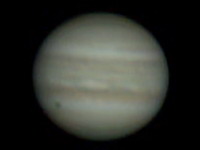
Time Lapse Movie
(29 seconds, 320x240, 293k WMV)
Hint: Right Click on movie link and "Save target as..." to download and
play on your desktop. |
| Jupiter - May 18, 2006, 10:30pm This image was
taken from the lower parking lot on Observatory Hill. We experienced
quite stable viewing in the direction Jupiter was located over the city,
which was surprising. The amount of colour saturation in the equatorial
bands yields almost a chocolate brown colour.
217 images taken over 126 seconds using the Meade LPI webcam and Envisage software on a Meade
LX-90 f/10 SCT. Envisage stretched the image between 0-71 out of 255 values.
Red, green & blue components of the image were aligned using ImagesPlus;
image cropped and annotated using Corel PhotoPaint X3. |
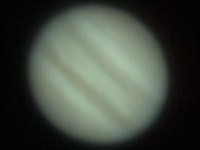 |
| Io Shadow Transit of Jupiter - May 13, 2006 After
the public left the Centre of the Universe, several Victoria Centre members
remained to enjoy the clear and fairly stable observing conditions. Since
there was a full Moon, I decided to stick with planetary viewing. My
target was Jupiter. This is my first time lapse video of a planet in motion, and it shows the
shadow transit of Io, one of Jupiter's moons.
2,310 original images acquired using the Meade LPI webcam and Envisage software on a Meade
LX-90 f/10 SCT, resulting in 12 images. These 12 images processed using ImagesPlus to automatically align, crop and
stretch images; Windows Movie Maker used to insert titles and create a
movie from the 12 jpg files. |
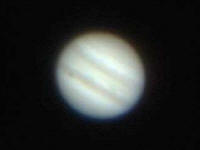
Time Lapse Movie
(15 seconds, 320x240, 284k WMV)
Hint: Right Click on movie link and "Save target as..." to download and
play on your desktop. |
| Comet 73/P Schwassman-Wachmann - May 2, 2006 Taken
when the comet was in Hercules. 68 Herculis is in the field of view of the
photo below the comet. Schwassman-Wachmann C 73/P has a very distinct
tadpole shape. I don't see two nuclei either visually or in this image.
Canon 30D dSLR 400mm telephoto (efl=640mm); f/6.3 exposure: 43
seconds each, ISO 1600, raw development using Canon Digital Photo Pro, 10
images aligned (on the comet head) and stacked, moderate Digital Development
applied using ImagesPlus, NeatImage auto, crop and resize using Corel
PhotoPaint. |
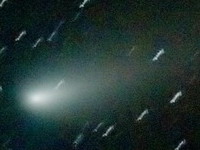 |
| Total Solar Eclipse observed from the Libyan Sahara Desert -
March 29, 2006 We have returned from the Jalu South Camp through
Benghazi to Tripoli. The eclipse was a tremendous success, with the weather
being absolutely perfect. Our RASC group arrived the day before the eclipse
and claimed our tents in the Sahara Desert at the camp. There were perhaps
500-1,000 people at our camp, and I could see at least two other camps
nearby. Everyone was pretty excited to finally be at our destination - the
reason for our long journey.
The following morning, everyone was well-rested and ready to go. First thing
was equipment checks and setup. We had lots of curious Libyans and fellow
campers (from around the world) asking us questions about ourselves, our
equipment, and (in the case of the Libyans) what we thought of their
country. The atmosphere was very energized. We had two weathermen with
us, as well as a half dozen experienced eclipse chasers, all of whom I found
personally very helpful.
As we counted down to First Contact, people were really getting excited.
Finally, "first contact" was shouted out, and we all looked up to see the
first chunk of the Sun being eclipsed by the Moon. What a strange site! Over
the next few minutes more and more of the Sun was eclipsed, until we could
feel the temperature of the Saharan heat start to drop. Next came a strange
change in the colour of the surrounding light. As things started to darken
more, the temperature also dropped more - a total of 7 or 8�C by the end.
At Second Contact, the Moon totally eclipsed the Sun, and the Diamond Ring
(see my image above) appeared for a brief few seconds, closely followed by Baily's Beads and solar flares. What a site, and it happens so quickly! Then
for 4 minutes we have the total eclipse to enjoy and photograph. The Sun's
corona was magnificent, flowing outward from the Sun in huge streamers. I was
taking photographs all through the sequence. The full eclipse phase is so
strange, since no solar filters are needed to observe the Sun while
fully-eclipsed by the Moon.
Too soon we came to Third Contact, where we have to again use solar filters,
since the energy of the Sun is now at full strength. Some of our group
observed until Fourth Contact, making observations along the way. Being less
dedicated, I stopped photographing during this phase, and just enjoyed the
occasional glance at the eclipsed sun through my binoculars. A solar eclipse
can be enjoyed in many ways - direct observation, photography, and observing
changes in the light and wildlife in the area, or just sharing the
experience with others. We have a great group, with everyone helping each
other to enjoy the experience. We did a fair bit of ambassadorship for
Canada, the RASC, and astronomy in general - Sidewalk Astronomy in the
Sahara! |
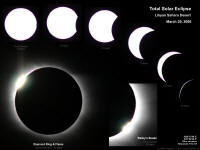
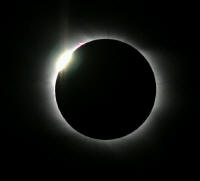
More photos and details:
The Sun |
| M45, Pleiades - Dec 11, 2005 12:35am
- I have auto-guiding working with my LX-90, the LPI, and the Meade
Envisage software. I piggybacked my Canon 300D Digital Rebel with
400mm EF L series telephoto, yielding an EFL of 640mm. This setup provides
an ideal platform for deep sky imaging of objects the size of the
Pleiades. This image is a stack of 6 images with exposure times of
60 seconds each. I was using an IDAS LPS filter, and yet if I increased
the exposure to 120 seconds, sky glow overtook the image since I was
imaging from my front yard in Victoria. A darker site would allow me to
gather more photons and increase the nebulosity. This represents my best
result to date with this object. Details: Canon Digital Rebel 300D
dSLR, Canon EF 400mm f/5.6L USM telephoto lens (efl=640mm), piggybacked on
a auto-guided LX-90. 6 images, exp 60 sec,
f/6.3, ISO 800, daylight WB, IDAS LPS filter. ImagesPlus: aligned using
auto correlate rotate and shift, stacked using Adaptive Addition,
aggressive Digital Development. Neat Image
applied. Corel PhotoPaint: cropped, contrast stretch, saturation and
contrast increased, hand-spotted processing artifacts. |
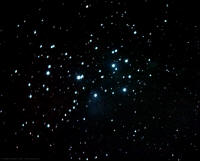 |
| Mars - Dec 10, 2005 10:30pm
- A frustratingly long stretch of storms and clouds have kept us from
observing Mars for the last three weeks, but finally we had a break for a
couple of evenings. Mars is now smaller than in late October and November,
however there is still much planetary detail to observe and photograph. Details: Meade LX-90 SCT
operating at f/25, Meade LPI Imager, 0.08 sec exposure, gain=0, offset=54.
202, 143, 173, 221, 303, 100 images auto stacked and Hard edge enhanced using Meade Envisage AutoStar Suite software,
resulting in 6 images.These 6 images were then auto planet aligned using
ImagesPlus and stacked to one resultant image. Moderate contrast stretch,
increased saturation applied, as well as up-sampling to 130% of original
size (in 10% increments) using Corel PhotoPaint. |
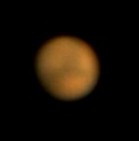 |
| Mars - Nov 17, 2005 8:30pm
- This is the first chance we've had to observe Mars after a couple of
weeks of storms tracking through our area. Details: Meade LX-90 SCT
operating at f/25, Meade LPI Imager, 0.125 sec exposure, gain=0, offset=50. Moderate contrast stretch..
59 images auto stacked and Hard edge enhanced using Meade Envisage AutoStar Suite software. |
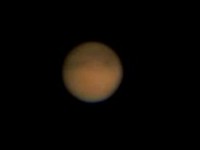 |
| Mars - Oct 26, 2005 11:00pm
- Although a storm front had just gone through our area, the stability was
remarkably good this evening. Details: Meade LX-90 SCT operating at
f/25, Meade LPI imager, 0.125 sec exposure. Images Plus: 57 images aligned
and stacked (averaged), moderate contrast stretch and saturation
enhancement, 10 iterations of adaptive Richardson-Lucy 5x5. |
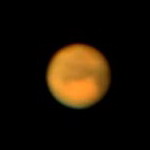 |
| M31, Andromeda Galaxy & M32,
M110 - Oct 3, 2005 10:30pm - Taken from
Astronomy Caf�.
This is about as deep as I've managed to image M31. Using a variety
of images taken with ISO 800 and 1600 is a well-known technique to tease
out more detail near the core of this galaxy, while still showing detail
in the outer reaches as well. Details: Canon Digital Rebel 300D, 400mm
telephoto lens with IDAS LPS filter, piggybacked on the LX-90 operating
with normal tracking in alt-az mode. Exposures of 60 sec and 90 sec,
f/6.3, ISO800 & 1600, 5 out of 14 images stacked, contrast stretched, noise reduced, rotated and
cropped, spotted, and colour balance adjusted. |
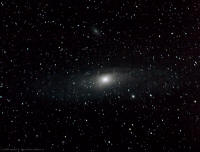 |
| Moon in daylight - Sept 23,
2005 8:34am - This image of the Moon was taken in morning daylight
using a 400mm telephoto lens on my Canon Digital Rebel. There is a
wide range of colours in the image, and due to the stable early morning
air, the image has excellent resolution. The beautiful blue sky
background sets off the lunar colours. Details: Canon Digital Rebel 300D
dSLR, Canon EF 400mm f/5.6L USM telephoto lens, tripod mounted, 1/430 sec,
f/6.3, ISO 200, daylight WB, circular polarizing filter. Neat Image
applied, cropped, contrast stretch, saturation and contrast increased, adaptive unsharp applied. |
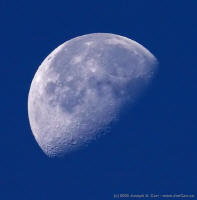 |
| Moon in daylight - Sept 23,
2005 8:34am - This is the same image as above, but illustrates how
different processing can produce radically different resulting images. In
this version the colour balance was normalized to eliminate the strong
blue bias to the image. Although some detail is lost along the eastern
limb, the enhanced colours in the mares and along the terminator make for
a fascinating image. |
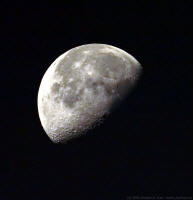 |
| Sunspot 798 - Sept 10, 2005
2:27pm - This huge sunspot is spewing flares and large amounts of
solar energy as it grows and morphs hourly. Once the Sun rotates a
bit more, this solar storm will point at Earth and will unleash lots of
protons towards us. Satellites and other spacecraft will be
affected, and aurora are likely within the next few days. Details: Meade
LPI mounted on a Meade ETX-60AT refractor using an Identiview solar
filter. 54 images taken over 43 seconds, stacked and Hard edge enhanced
using Meade Envisage AutoStar Suite software. Exposure time 0.003 sec,
gain=76, offset=0. Moderate contrast stretch. |
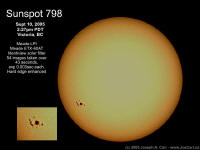 |
| M31, Andromeda Galaxy & M32 -
Sept 2, 2005 10:30pm - Taken at the Fifth
Annual RASCALS Star Party 2005 located at the Victoria Fish & Game,
Malahat, BC. For the first couple of hours of observing, the skies
rewarded us with inky black and very stable conditions. Everyone was
awestruck, and then it ended as the clouds closed 50% of the sky to
observing. I have never observed nor photographed M31 with such
detail visible before. Details: Canon Digital Rebel 300D at prime focus
behind the LX-90 operating at f/6.3 in polar mode. Exposures of 60 sec and 120 sec, ISO800,
7 out of 14 images stacked, contrast stretched, noise reduced, rotated and
cropped, and colour balance adjusted. |
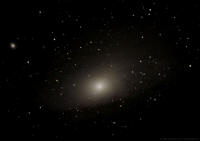 |
| Aurora over Victoria -
August 26, 2005 9:58pm - Six RASC members and I were treated to a rare
event as we were observing from Cattle Point - an aurora over the city to
the southwest. There was just one green spire, but it floated and
bobbed around the handle of the Big Dipper for over a half hour, then
disappeared for good. Details:
Canon Digital Rebel 300D, fl=10mm, f/4.5, ISO 800, 30 sec. Original image cropped
and a moderate contrast stretch and noise reduction applied to enhance the
aurora. Red channel contrast compressed reduce the effects of light pollution.
Camera piggybacked atop a Meade LX-90, alt/az tracking |
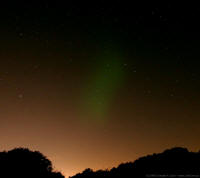 |
| Milky Way - August 26,
2005 10:13pm - Six RASC members and I experienced the best observing
conditions this year from Cattle Point. The Milky Way was nothing
short of spectacular, especially considering our urban location. This wide
field image covers 100� of the sky, with north to the left. Details:
Canon Digital Rebel 300D, fl=10mm, f/4.5, ISO 800, 91 sec. Moderate
contrast stretch and noise reduction applied. Camera piggybacked atop a
Meade LX-90, alt/az tracking. |
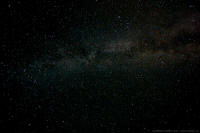 |
| Perseid Meteor - August 11, 2005 10:49pm -
I joined seven other RASCALs at our Jane's Farm
location in Central Saanich to observe the Perseids. Between 10pm
and midnight we observed an average of 10-20 meteors per hour, which was
an improvement in the rate over last year's showing (Perseid
Meteors - 2004). I must confess,
I didn't observe this meteor which I managed to capture using my dSLR.
Well before midnight all our camera gear was covered in dew, so it was
fortunate that I captured this Perseid early in the evening! Details:
Canon Digital Rebel 300D, fl=10mm, f/4, ISO 800. Original image cropped
and a moderate contrast stretch and noise reduction applied to enhance the meteor
and reduce the effects of light pollution. |
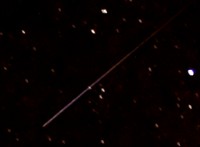
This Perseid meteor is zooming through
the constellation Cygnus and the Milky Way. Deneb is the bright star to
the right. This widefield image
also shows Cassiopia in the lower part of the image |
| Antares Grazes the Moon - July
17, 2005 - I was observing from Cattle Point.
This image was taken at 8:41pm but I had the feeling I started too late.
It shows Antares taken through my LX-90 using my Canon Digital Rebel at
f/10 prime focus. |
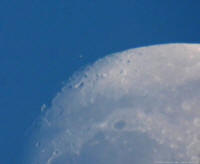 |
| Antares Grazes the Moon - July
17, 2005 - It was a lovely evening at Cattle
Point, so I had to capture the moment with a wide angle shot of the
southern horizon, including the shoreline and the Moon. |
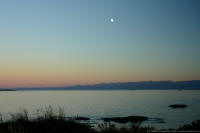 |
|
Sun - solar flares - June 30, 2005 4:40pm - RASC
Victoria Centre recently acquired a new Coronado Solarmax 40
hydrogen-alpha filtered telescope. Bruno and I were having a good
time observing solar flares, and just getting a feel for how Coronado's Ha
system works. I thought it would be fun to try taking some images
using the Meade LPI webcam.
The top-most image is full colour, with an aggressive
contrast stretch. A couple of the solar flares Bruno and I were
observing are highlighted on the image.
The middle image is the result of an aggressive edge
detection filter applied to the red band of the image. Lots of jpg
artifacts are visible.
The bottom image is the result of an aggressive contrast
stretch applied to the red band of the image.
All three images are derived from a single image taken at
1/100 second exposure - exposing for the flares, not the surface detail.
The experts say that 8 bit jpg is not the way to go with
Ha images, and I suppose these images illustrate that is true. These
images also are not in focus, mainly due to the great difficulty achieving
acceptable focus when using an astronomical webcam during daylight
conditions, but also because we had about a 40% high cloud cover.
Nonetheless, here is my first attempt at imaging through a Ha filter.
Read Sid's preliminary
Solarmax 40 Report. |
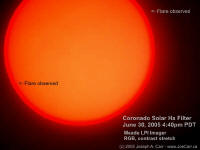
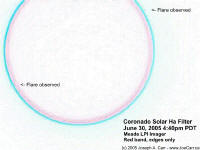
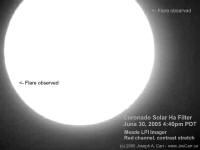 |
|
Planetary Conjunction - Venus-Mercury-Saturn -June 27,
2005 10:20pm - It was a rainy day in Victoria, and most of our
"regulars" on Observatory Hill probably decided the best night for the
conjunction was a wash-out. However by 8pm, the clouds parted and by sunset all three
planets popped out of the scattered clouds to give everyone a good show
along the northwestern horizon. This image
is taken from the old 16" site atop Observatory Hill. Venus and
Mercury are 9' apart, side-by-side between the cloud layers near the
centre top of the image. Saturn is low in the sky near the horizon
by the house lights on the hill to the right.
Taken with a Canon Digital Rebel: 200mm fl, 1/3 sec, f/5.6,
ISO 400. Cropped, image size reduced, moderate contrast stretch
applied to bring out the planets, and Neat Image applied to reduce noise. |
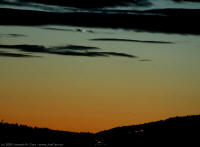 |
|
Planetary Conjunction - Venus-Mercury-Saturn -June 25,
2005 10:00pm - All three
planets never did "pop out" of the northwestern horizon's haze
this evening, much to the disappointment of several RASC members who were
trying to observe this conjunction. This image is taken from the old
16" site atop Observatory Hill but only shows Mercury and Venus within 30' of each other.
Saturn is not visible in the image, although it was observed now and then
as the clouds occasionally lifted.
Taken with a Canon Digital Rebel: 90mm fl, 1/25 sec, f/5,
ISO 400. Cropped and moderate contrast stretch
applied. |
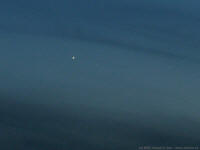 |
|
Jupiter, Great Red Spot, Shadow Transit - June 25, 2005
9:34pm - While the RASC members were struggling to view the planetary
conjunction (above) through the clouds, Guy Walton pointed out we were
missing another planetary show - Jupiter, the GRS and a Shadow Transit.
This image represents my best result so far to image
Jupiter, and the first time I've successfully imaged the GRS. The
GRS is clearly visible on the right side of the upper band. The
shadow transit of Io is very apparent in the lower band as a distinct
dark spot. The moon Io itself is also just visible in the lighter-coloured
band (below the dark band the shadow is in) near the right edge of the
planetary disk.
Taken with a Meade LPI webcam, Gamma 100,
Offset 32, Exposure 0.15 sec, 70% quality setting. Hard Edge Filter. 20
images auto stacked with AutoStar Suite. Scaled up 5x10% to 150% of
original size in Corel PhotoPaint. |
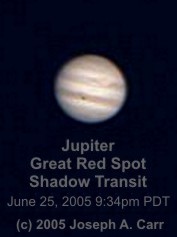
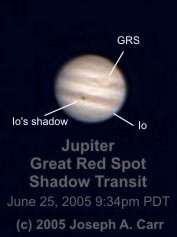 |
|
Planetary Conjunction - Venus-Mercury-Saturn -June 22,
2005 10:13pm - It took almost an hour after sunset for all three
planets to "pop out" of the northwestern horizon's haze. This image
is taken from the old 16" site atop Observatory Hill. Several other RASC
members were also observing this conjunction - a practice run for a few
days hence when Mercury and Venus are within 5' of each other.
Taken with a Canon Digital Rebel: 100mm fl, 1/6 sec, f/5,
ISO 400. Cropped, image size reduced, aggressive contrast stretch
applied to bring out the planets, and Neat Image applied to reduce noise. |
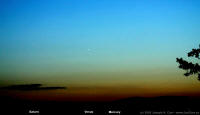 |
|
June 9, 2005, 11:04pm - Jupiter double shadow transit -
David Lee and I rendezvoused at the Centre of the Universe as twilight
faded. We had a mission: use our webcam planetary imagers to capture the
double shadow transit on Jupiter. Clouds dogged our efforts, but at the appointed hour, the
clouds thinned enough to allow David to image using the 16" CU telescope
and his new Celestron Neximage, and I imaged using my 8" LX-90 SCT and my Meade LPI.
The two shadows are clearly visible side by side in this image. |
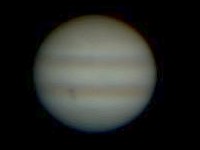 |
|
April 9, 2005 - Saturn - At the Centre of the
Universe, evening twilight revealed Saturn in all her glory. An hour
or so later, the air was very stable and the crowds were light, so I took
advantage and connected my Meade LPI webcam to the 8" LX-90 SCT. Cassini
Division and an equatorial band are clearly visible in this image.
Image details |
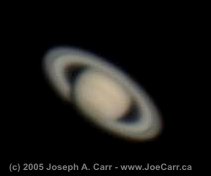 |
|
March 11, 2005 - Moon - Mercury - In
the evening twilight, Mercury is high in the sky and only 3� north of the
waxing, one day old crescent Moon. Earthshine on the dark side of the Moon
reveals lunar features. Light pollution over Victoria reflects off the
clouds.
Photo
details
|
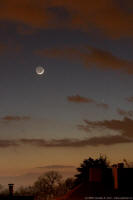 |
|
Jan 4, 2005 - C/2004
Q2 Comet Machholz - observed from Bruno's place. I used my LX-90's
tracking, and stacked multiple images at f/6.3 using my Canon Digital
Rebel 300D at prime focus. Still no comet tails visible (even in the
negative image), despite the nice deep image.
Photo
details |
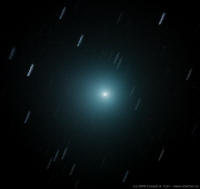
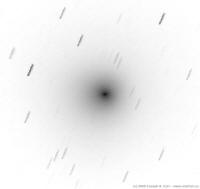 |
|
Jan 4, 2005 - C/2004
Q2 Comet Machholz, Pleiades & Hyades - observed from Bruno's place.
I used my LX-90's tracking, piggybacked my Canon Digital Rebel 300D using
my 18-55 zoom lens and stacked multiple images. Still no comet tails
visible, despite the nice deep image.
Photo
details |
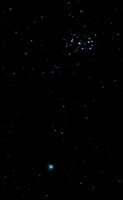 |
|
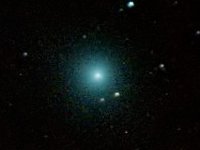 C/2004
Q2 Comet Machholz - observed from
Astronomy Caf� - Dec 27/04
by Bruno Quenneville, Joe Carr (photo
details), David Griffiths, Malcolm Scrimger & Larry Danby. C/2004
Q2 Comet Machholz - observed from
Astronomy Caf� - Dec 27/04
by Bruno Quenneville, Joe Carr (photo
details), David Griffiths, Malcolm Scrimger & Larry Danby.
We all
saw a bright core and a rather large blue-green coma, despite the full Moon.
Malcolm thought he saw a bit of a tail.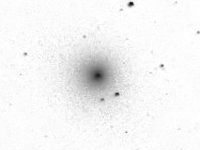
Here is a B&W negative version of the above colour image.
|
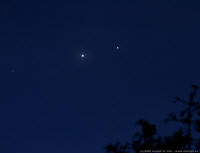
Venus-Jupiter Conjunction
The two planets were only 0.6� apart
on the morning of Nov 5, 2004
|
|
Lunar Eclipse - Oct 27,
2004
|
|
Occultation by Aircraft!
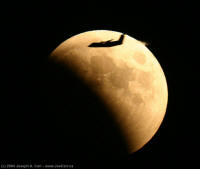
What are the odds of an aircraft
passing in front of an eclipsed Moon? Well here it is!
Oct 27, 2004,
6:45pm PDT, Location: Mt.
Tolmie
More of Joe's photos of
The Moon
As featured on
Spaceweather.com and
space.com
|
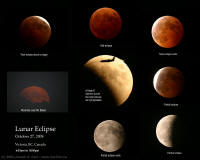
A composite of the eclipse from Moonrise
through to when the partial eclipse ended |
|
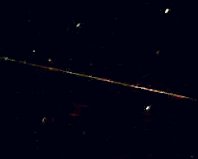
Perseid Meteor
Photo taken Aug 12/04 at 12:53am
at the Lochside Drive at Jane's
Farm Observing Site
Observers: Chuck Filtness, Bruno Quenneville, David Griffiths,
Malcolm Scrimger
|
Multiple sunspots!
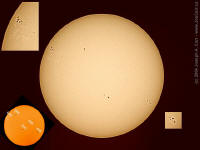
Photo
by Joe Carr - July 13, 2004
How about those sunspots?
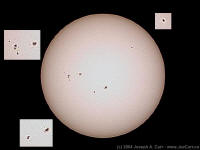
Photo
by Joe Carr - June 18, 2004
|
Aurora at the Island Star Party
July 24/25, 2004 (midnight)
|
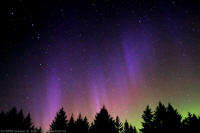 |
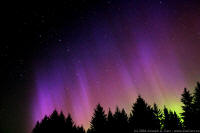 |
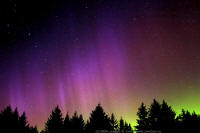 |
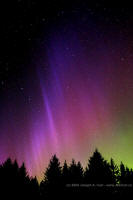 |
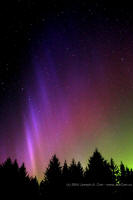 |
|